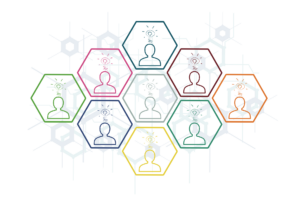According to World Scientific, innovation analytics is a specific, emerging model that integrates information, analytics, digital twins and even artificial intelligence to support and manage the entire lifecycle of a product or process from inception, through design and manufacture. With the use of data analysis tools, companies can then gain insights that inform decision-making related to product development, identify market trends and opportunities, zero in on customer preferences, streamline operations and more. Innovators can also leverage analytics to better weigh their development options and outcomes before they commit resources to a project.
Decentralized Versus Centralized Organizations
While data presents an opportunity for companies to innovate, there remain concerns about how best to use the large amount of data being generated today through more advanced digital means. Data quality and data overload are also concerns in today’s digital environment.
For more efficiency with data in their operations, companies may also find themselves balancing decentralized versus centralized initiatives depending on their specific needs. In her latest research, “How Data Analytics Can Drive Innovation,” Wharton professor of operations, information and decisions Lynn Wu looks at how different organizational structures influence the use of data analytics to spur innovation. The Wharton School is part of the University of Pennsylvania.
There are certainly advantages and disadvantages to each approach. According to Professor Wu, a decentralized structure is based more on an innovation and collaboration network, which could be comprised of a variety of smaller groups that are loosely connected together. A centralized structure is one where innovators are more concentrated, where a small group of individuals are mostly responsible for the innovations of the company.
As far as how these structures impact innovation—and what analytics can do for these organizational groups—Professor Wu found that data and analytics can drive decentralized innovation for several reasons. “What I find is that analytics can really drive the creation of recombinations, or combining a diverse set of existing technologies in a new way. Each individual technology already exists, but how do we recombine them in some ways to create a new innovation?” says Wu.
For Wu, decentralized seems to hold a slight advantage in that there are smaller clusters working on a specific problem, so they really know what the problem is in that domain, and may find a solution faster. However, a decentralized structure can lack the tighter coordination of a centralized group, which may also be better at looking at the big picture of a problem.
There is really no one answer to which organization is better equipped for innovation. But, this is where the power of data and analytics comes into play for either approach. “Analytics finds a way to cull through that and find you a new combination, a new way of solving your problem that you may not have easily found without analytics,” says Wu.
A Pivotal Solution
All Things Innovation looked at the aspect of how data can drive innovation in a case study, “How Data-Driven Innovation Brought a Deliciously Satisfying Solution to Market.”
Everipe is a growing startup that harnesses the power of freeze-dried technology to create nutrient-rich smoothies. But like many marketers and insights professionals, the founders found it challenging to quantify the concept’s potential.
To help the company get a sense of Everipe’s in-market potential and benchmark their product against core competitors, Dig Insights leveraged its innovation insights platform, Upsiide. Upsiide makes it easy to screen ideas and test concepts in whatever format they come – creative, messaging claims, food packaging, or logos. The team used Upsiide’s methodology to understand consumers’ intuitive interest and initial commitment to the Everipe proposition, as compared with the propositions of their key competitors. Dig then ran a study that dove deep into the Everipe brand and product portfolio to understand how consumers felt about the brand and packaging.
As one of the founders of Everipe put it, “It was a pivotal moment for us to hear from a robust sample set – [the data shows that] we have a very powerful idea. So, we’re now spending the dollars to bring a team of consultants in, solidify our brand and products, and scale production. Talk about actionability out of insight! I’m not sure we would have had the confidence to invest without the clarity that Dig’s study brought us.”
Welcome to the Machine
What steps can organizations take to develop innovation data and analytics tools to help drive innovation? We asked ChatGPT that question to zero in on specific steps to take that can ramp up a company’s use of data in their product development efforts.
- Establish an innovation data and analytics team: Organizations should create a team dedicated to developing, managing, and analyzing innovation data. This team should include experts in the fields of data science, analytics, design thinking, business intelligence, user experience research and product management.
- Collect data across all areas of the organization: Companies need to collect relevant information from all departments within their organization in order to develop meaningful insights into how they can innovate better. Data sources could include customer feedback surveys, sales reports or market research studies.
- Utilize predictive analytics: Predictive analytics is a powerful tool for predicting future trends based on past performance and other factors such as customer behavior or industry trends. By utilizing predictive analytics tools, organizations can gain insight into potential opportunities for innovative products or services before they launch them into the marketplace.
- Implement agile methodologies: Agile methodology helps companies quickly respond to changes in the marketplace by allowing them to rapidly prototype new ideas without investing too much time or money upfront. By implementing agile methodologies, organizations can quickly test out different concepts while collecting valuable feedback from stakeholders along the way.
- Leverage machine learning algorithms: Machine learning algorithms are used by businesses today to automate processes, identify patterns, detect anomalies, make predictions, generate insights, optimize operations and more. By leveraging these advanced technologies, companies can tap into vast amounts of structured and unstructured datasets that may have previously been inaccessible due to manual analysis limitations.
Staying Agile
As the suggestions from ChatGPT indicate, the world is changing rapidly with the advancement of automated data gathering and analysis tools, as well as the growth in data transformation and visualization technology.
But as the case study from Everipe suggests, there is a human element to analyzing the data and making the best decisions for the business or brand. These decisions can be utilized in both centralized or decentralized organizations, where the needs of humans can be balanced with the advances in technology to come up with ideal solutions that will be ripe for the picking.
Video courtesy of Gartner
Contributor
-

Matthew Kramer is the Digital Editor for All Things Insights & All Things Innovation. He has over 20 years of experience working in publishing and media companies, on a variety of business-to-business publications, websites and trade shows.
View all posts




























































































































